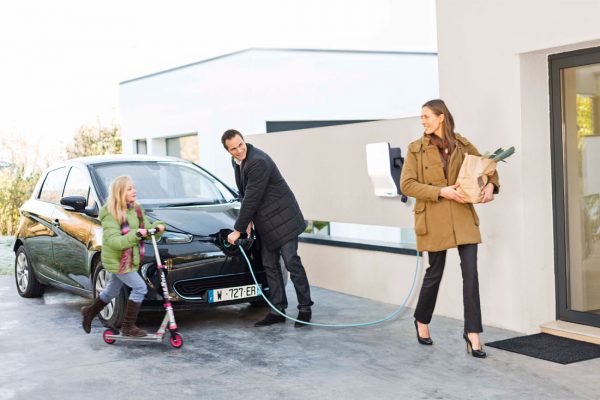The impressive growth trajectories forecasted for electric vehicles (EV) presents both unparalleled opportunities and unprecedented challenges. How do you best navigate these waters? Peter Grönwall of Schneider Electric shares more

June 19th, 2019
The impressive growth trajectories forecasted for electric vehicles (EV), battery technologies and digitisation present both unparalleled opportunities and unprecedented challenges for auto manufacturers, consumers, fleet operators, electric utilities, oil and gas companies and other key industry stakeholders.
For vehicle manufacturers, there are large groups of customers who, by moving to EV truck fleets, for example, can cut their vehicle operational and maintenance costs by up to 50 per cent.
On the other hand, it is not easy for auto manufacturers to flip a switch from producing internal combustion engine (ICE) vehicles to EVs. Factory physical infrastructures will need to modernise, and manufacturing lines for both types of vehicles will need to be maintained for quite a few years.
For electrical utilities, a robust network of EV charging stations represents a major opportunity for selling more electricity to consumers and for increasing grid efficiencies with new access to more stored energy.
EVs and digital innovations drive energy efficiency improvements by coordinating charging systems to grid capacities, thereby improving energy efficiencies and reducing the need for new lines and transformer stations.
Even repurposed EV batteries used as storage can offer the possibility of regulating the grid or smoothing out peak demand when used as energy storage. This network “service” represents economic value. EVs are thus a significant source of flexibility in electricity demand.

Modern smart charging stations make highly efficient use of the grid. Current charging profiles of EV drivers indicate that they charge three times a day, often at morning time, lunch or during the evening. Instead of investing in large connections to the grid that are expensive and inefficient (since they are not in use for most of the day), a more pragmatic approach is to invest in a charging station that offers a battery storage option.
When drivers want to charge their vehicle, they can source their power either from the grid or from the battery storage. The charging station can be programmed to optimise the lowest price scenario for that particular time of the day.
For instance, the stations can repurpose lithium-ion automobile batteries as an OEM-packaged energy storage option. As ICE cars lessen in numbers while EVs increase, used lithium-ion batteries from ICE cars will present a low- cost option for supplying energy storage to some of these charging systems.
On the other hand, fleet intensive organisations that house and operate hundreds of vehicles throughout the day can use solar or wind power installed on the roofs of their facilities to charge their EV battery storage.
Smart charging stations are configured and designed so that they can use both traditional grid power in addition to solar and wind resources. The surplus power can be sold back to the grid if grid demand is high and the battery control system suggests such an action.
Depending on the region, power purchased at night or at low load time of the grid can be 10-40 per cent less expensive and used during times when costs are high.

Modern charging stations are, in essence, network connection points capable of accessing the cloud and supplying electrical power when needed. Within these technologies, companies like Schneider Electric have designed in the ability to safely and securely connect data and send data to the point operator and to the electric power consumer.
Related software also allows for remote technical support, efficiency optimisation, and predictive maintenance. These services provide the consumers of these technologies with maximise uptime and performance of their field and facility charging stations assets.
To learn more about the ways charging stations are helping to drive EV proliferation and corresponding low emissions benefits, click here.
INDESIGN is on instagram
Follow @indesignlive
A searchable and comprehensive guide for specifying leading products and their suppliers
Keep up to date with the latest and greatest from our industry BFF's!

It’s widely accepted that nature – the original, most accomplished design blueprint – cannot be improved upon. But the exclusive Crypton Leather range proves that it can undoubtedly be enhanced, augmented and extended, signalling a new era of limitless organic materiality.

How can design empower the individual in a workplace transforming from a place to an activity? Here, Design Director Joel Sampson reveals how prioritising human needs – including agency, privacy, pause and connection – and leveraging responsive spatial solutions like the Herman Miller Bay Work Pod is key to crafting engaging and radically inclusive hybrid environments.

The client’s brief was clear: create an environment that honoured FIN’s heritage while embracing its future. For Intermain, that meant rejecting the idea of the corporate, “boring” office and instead leaning into a space that would inspire, connect, and surprise.

Nicole Larkin has been awarded the 2025 Marten Bequest, providing two years and $50k to research coastal resilience and adaptation.

Though a retail space, Jardan Byron Bay feels like home, with thoughtfully layered spaces that intimately reflect the local context.

The Australian Passivhaus Association (APA) has released a guide outlining the process for achieving the international Passivhaus Standard, providing clarity on appropriate use of the term and the legal risks of incorrect assertions.
The internet never sleeps! Here's the stuff you might have missed

Spacemen Studio foregrounds fabric and colour in a hospitality project inspired by the ritual preparation of matcha.

The client’s brief was clear: create an environment that honoured FIN’s heritage while embracing its future. For Intermain, that meant rejecting the idea of the corporate, “boring” office and instead leaning into a space that would inspire, connect, and surprise.